Vietnam’s northern frontier is home to some of the country’s most spectacular natural landscapes, and Cao Bang Waterfall stands out as one of its most mesmerizing attractions. Nestled in the remote reaches of Cao Bang Province, this stunning cascade captivates visitors with its raw beauty, powerful flow, and serene surroundings. Unlike the more tourist-heavy destinations in Vietnam, Cao Bang Waterfall offers an unspoiled retreat where nature’s grandeur takes center stage.
When travelers think about waterfalls in Vietnam, the first name that often comes to mind is Ban Gioc Waterfall. While Ban Gioc Waterfall is undoubtedly breathtaking and iconic, it is only one of many stunning waterfalls in Cao Bang Province – a mountainous paradise in Northern Vietnam that remains surprisingly under-visited.
If you’re looking to get off the beaten path, connect with nature, and uncover awe-inspiring landscapes, Cao Bang Waterfall destinations offer an unforgettable escape. This blog will be your complete guide to visiting the top Cao Bang waterfall, including Ban Gioc and more.
Where is Cao Bang Province?
Cao Bang Province is located in Vietnam’s far northeast, bordering China’s Guangxi region. It’s about 300km from Hanoi. The land here is full of tall limestone mountains, deep valleys, and winding rivers. Many ethnic minority groups, like the Tay, Nung, and Dao people, live here.

The province stays cool all year, making it perfect for waterfall visits. The roads wind through small villages and rice fields, with stunning views at every turn.
Transport to Cao Bang Waterfall
Getting to Cao Bang requires some patience, but the journey is part of the experience. From Hanoi, travelers can choose between night buses, private cars, or even motorbike adventures. Sleeper buses from My Dinh or Gia Lam bus stations take around eight hours and are a budget-friendly option. Private transfers or guided tours provide more comfort and flexibility, especially if you plan to visit remote waterfalls.
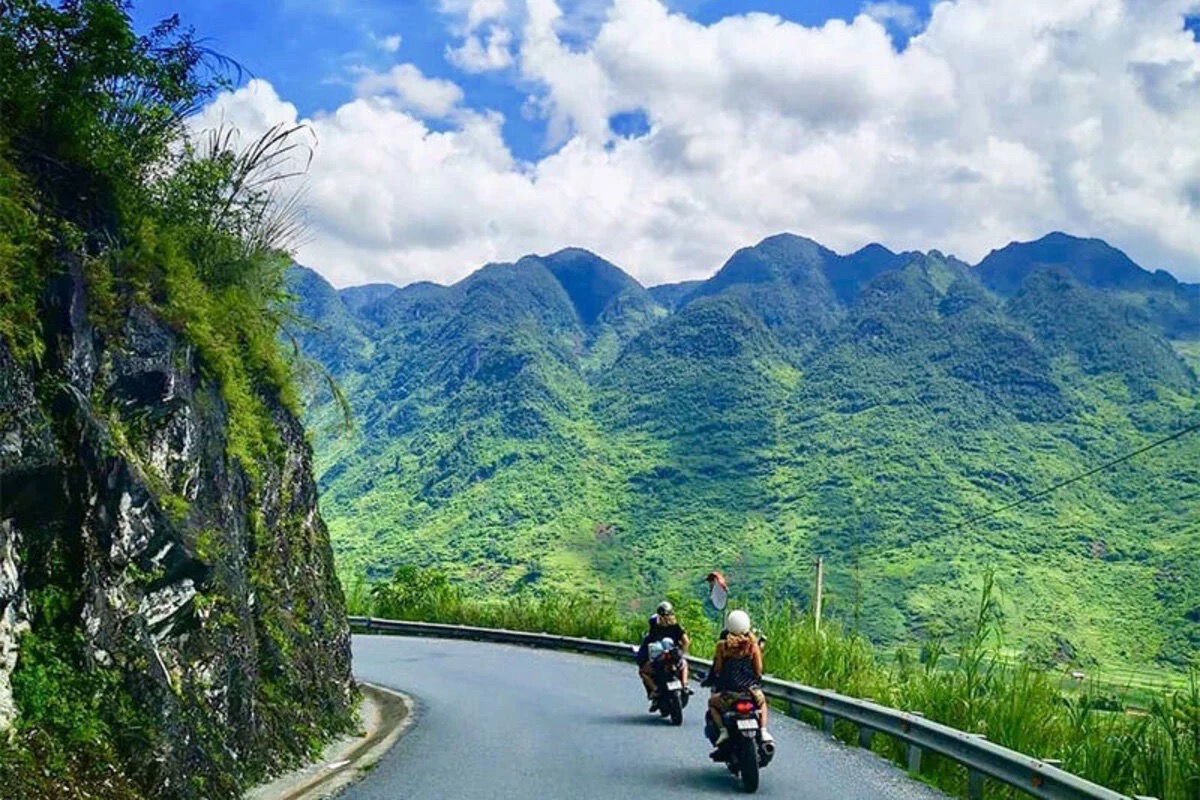
Once in Cao Bang City, reaching the waterfalls involves more scenic drives. Ban Gioc is about three hours away by car or motorbike. The road winds through mountains, past stilt houses, rice paddies, and small ethnic villages. To reach places like Nam Tra or Thang Hen, expect smaller roads, and sometimes even hiking trails, especially during the rainy season when the terrain gets slippery.
For safety and convenience, many travelers book local guides for their Cao Bang travel. This is especially helpful for reaching the hidden waterfalls, as signage can be minimal and translation limited in rural areas.
How much does an entrance ticket to Cao Bang Waterfall cost?
The costs to visit Cao Bang waterfall are modest. Entrance to Ban Gioc Waterfall costs 45,000 VND for adults, which is around 2 USD. Children pay half that price. A bamboo boat ride that takes you close to the base of the falls is available for 50,000 VND per person, offering a unique perspective and plenty of photo opportunities.
Nguom Ngao Cave, located just a few kilometers from Ban Gioc, has a separate entrance fee of 40,000 VND. The caves are not only fascinating geologically but also home to some underground waterfalls that echo through the chambers.
For other sites, such as Thang Hen Lake or Nam Tra Waterfall, entrance fees are minimal or sometimes nonexistent. These areas are often maintained by local communities or are free to access, though you may be asked to contribute a small amount for parking or local support. Hiring a guide, especially in remote areas like Nam Tra, is highly recommended and usually costs between 150,000 and 300,000 VND per day.
Top Cao Bang Waterfall You Shouldn’t Miss
Ban Gioc Waterfall (Thác Bản Giốc)
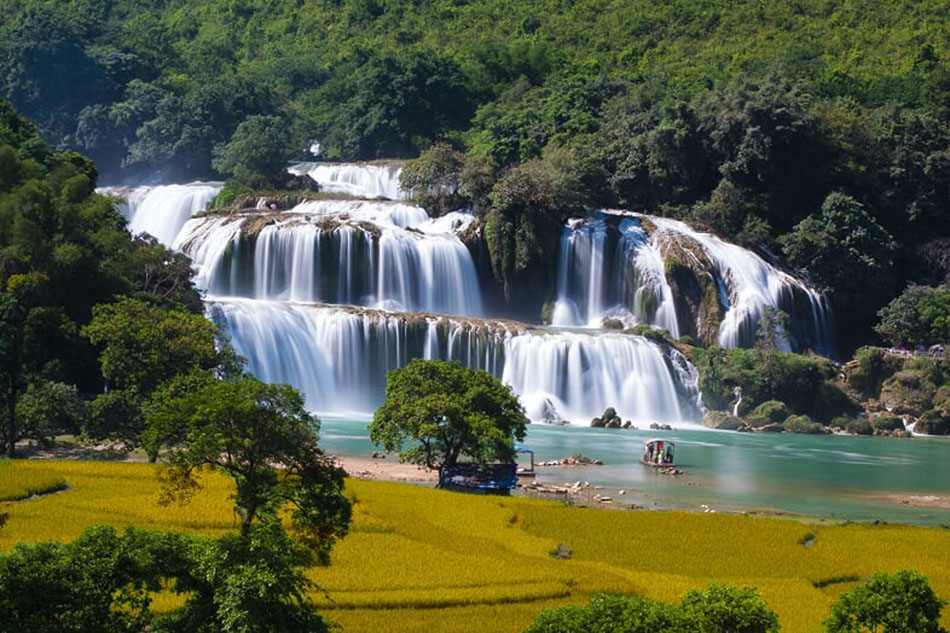 Undeniably the most famous, Ban Gioc Waterfall spans the Quay Son River and marks the border between Vietnam and China. It’s considered one of the largest and most beautiful waterfalls in Southeast Asia. Measuring about 300 meters wide and 30 meters high, it flows over layered limestone cliffs into emerald-green pools.The best time to visit is during the rainy season, from June to October, when water levels are high. However, it remains stunning year-round. Arrive early in the morning to enjoy the sight before the crowds gather. You can even take a bamboo raft close to the base of the waterfall for a more immersive view.
Undeniably the most famous, Ban Gioc Waterfall spans the Quay Son River and marks the border between Vietnam and China. It’s considered one of the largest and most beautiful waterfalls in Southeast Asia. Measuring about 300 meters wide and 30 meters high, it flows over layered limestone cliffs into emerald-green pools.The best time to visit is during the rainy season, from June to October, when water levels are high. However, it remains stunning year-round. Arrive early in the morning to enjoy the sight before the crowds gather. You can even take a bamboo raft close to the base of the waterfall for a more immersive view.Nang Tien Waterfall (Thác Nàng Tiên)
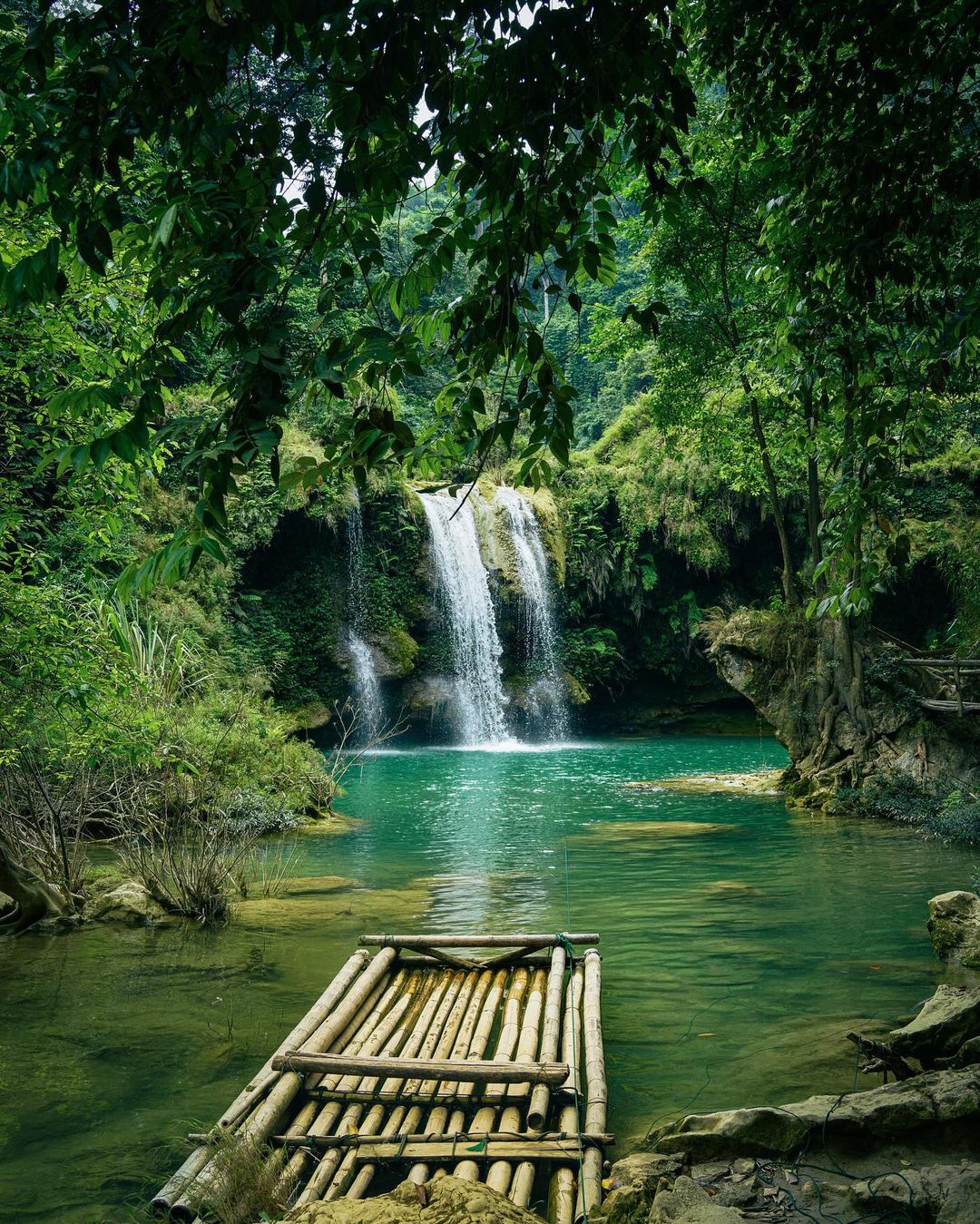 A hidden gem tucked away in the Phia Oac-Phia Den National Park, Nang Tien Waterfall is often referred to as the “Fairy Waterfall”. Located in Nguyen Binh district, this waterfall is surrounded by rich biodiversity and offers a fairy-tale-like ambiance.The name ‘Nang Tien’ – meaning fairy – comes from local legends about fairies bathing in its cool, crystal-clear waters. This Cao Bang waterfall flows down a mossy cliff, forming soft white streams that contrast beautifully with the deep green forest around it. It’s an ideal place for those seeking a tranquil escape.
A hidden gem tucked away in the Phia Oac-Phia Den National Park, Nang Tien Waterfall is often referred to as the “Fairy Waterfall”. Located in Nguyen Binh district, this waterfall is surrounded by rich biodiversity and offers a fairy-tale-like ambiance.The name ‘Nang Tien’ – meaning fairy – comes from local legends about fairies bathing in its cool, crystal-clear waters. This Cao Bang waterfall flows down a mossy cliff, forming soft white streams that contrast beautifully with the deep green forest around it. It’s an ideal place for those seeking a tranquil escape.Co La Waterfall (Thác Cò Là)
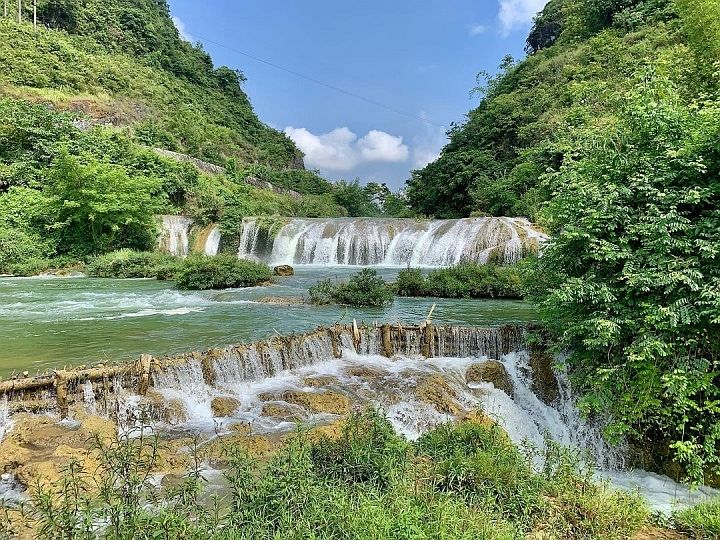 While Ban Gioc grabs all the spotlight, Co La Waterfall quietly captivates those lucky enough to discover it. Located in Ruoc Village, Chi Vien Commune, in the district of Trung Khanh, Co La lies in a Tày ethnic village rich with traditional culture.Surrounded by towering green mountains, Co La appears like a secret oasis embraced by nature. The water flows gently, producing a melodic symphony of trickling sounds blended with birdsong—an ideal place for relaxation and quiet reflection. In the summer, when water flow is lower, visitors can even bathe in the waterfall’s emerald pools, whose calm surfaces mirror the sky above.
While Ban Gioc grabs all the spotlight, Co La Waterfall quietly captivates those lucky enough to discover it. Located in Ruoc Village, Chi Vien Commune, in the district of Trung Khanh, Co La lies in a Tày ethnic village rich with traditional culture.Surrounded by towering green mountains, Co La appears like a secret oasis embraced by nature. The water flows gently, producing a melodic symphony of trickling sounds blended with birdsong—an ideal place for relaxation and quiet reflection. In the summer, when water flow is lower, visitors can even bathe in the waterfall’s emerald pools, whose calm surfaces mirror the sky above.Cho Waterfall (Thác Chó or Thác Tình)
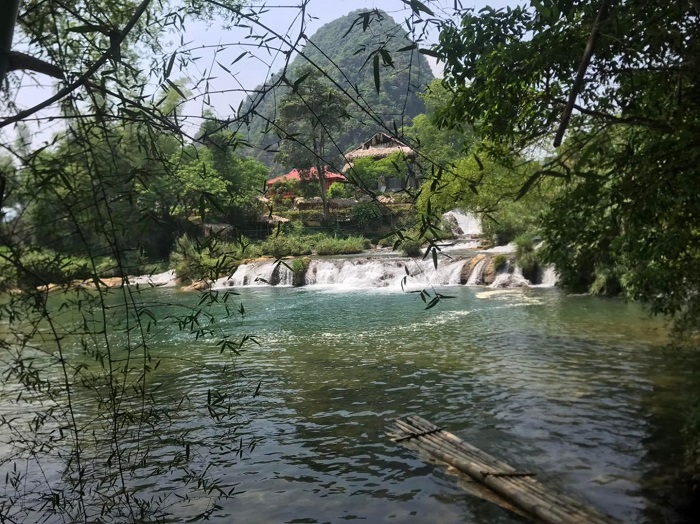 Cho Waterfall, also known by its more romantic name “Thác Tình” (Love Waterfall), is located in Na Ri Hamlet, Nam Tuan Commune, Hoa An District. Its peculiar name may raise eyebrows, but the beauty of the waterfall is indisputable.Featuring three gentle tiers and flowing freely across smooth rocks, Cho Waterfall does not overwhelm but rather invites visitors to sit back and absorb its peaceful rhythm. The surrounding forest is dense and verdant, thanks to the moisture from the falls, creating a striking contrast between the deep greens of foliage and the white froth of the water.Here, you can relax on the rocks, swim in the shallow pools, or simply enjoy the serene landscape with a camera or sketchbook in hand.
Cho Waterfall, also known by its more romantic name “Thác Tình” (Love Waterfall), is located in Na Ri Hamlet, Nam Tuan Commune, Hoa An District. Its peculiar name may raise eyebrows, but the beauty of the waterfall is indisputable.Featuring three gentle tiers and flowing freely across smooth rocks, Cho Waterfall does not overwhelm but rather invites visitors to sit back and absorb its peaceful rhythm. The surrounding forest is dense and verdant, thanks to the moisture from the falls, creating a striking contrast between the deep greens of foliage and the white froth of the water.Here, you can relax on the rocks, swim in the shallow pools, or simply enjoy the serene landscape with a camera or sketchbook in hand.Nam Tra Waterfall (Thác Nặm Trá)
 Hidden deep in the forests of Tra Linh District, Nam Tra Waterfall is one of Cao Bang’s most secluded treasures. Reaching it requires hiking through narrow paths and forest trails. But the effort is rewarded with a serene, multi-tiered cascade tumbling down mossy cliffs. The surrounding forest, alive with birdsong and rustling leaves, makes it feel like a sacred space.Nam Tra is not a tourist hotspot, which makes it ideal for travelers seeking solitude and authenticity. Bring good hiking shoes and consider going with a local guide who knows the way.
Hidden deep in the forests of Tra Linh District, Nam Tra Waterfall is one of Cao Bang’s most secluded treasures. Reaching it requires hiking through narrow paths and forest trails. But the effort is rewarded with a serene, multi-tiered cascade tumbling down mossy cliffs. The surrounding forest, alive with birdsong and rustling leaves, makes it feel like a sacred space.Nam Tra is not a tourist hotspot, which makes it ideal for travelers seeking solitude and authenticity. Bring good hiking shoes and consider going with a local guide who knows the way.Thoong Ma Waterfall (Thác Thoong Ma)
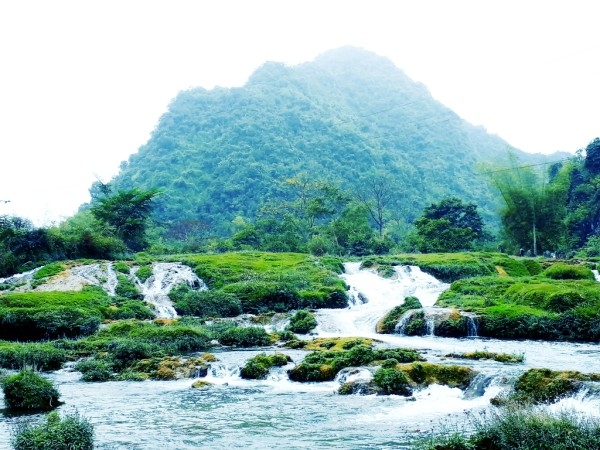
Recognized as one of the most beautiful Cao Bang waterfall, Thoong Ma waterfall is often paired with Nam Tra waterfall, Ban Gioc waterfall, and Co La waterfall in regional rankings. Although fewer visitors explore it, Thoong Ma stands out with its strong flow and dramatic cascades set in a lush valley. It’s both photogenic and powerful, offering a perfect balance between visual impact and natural tranquility.
Waterfalls Inside Nguom Ngao Cave
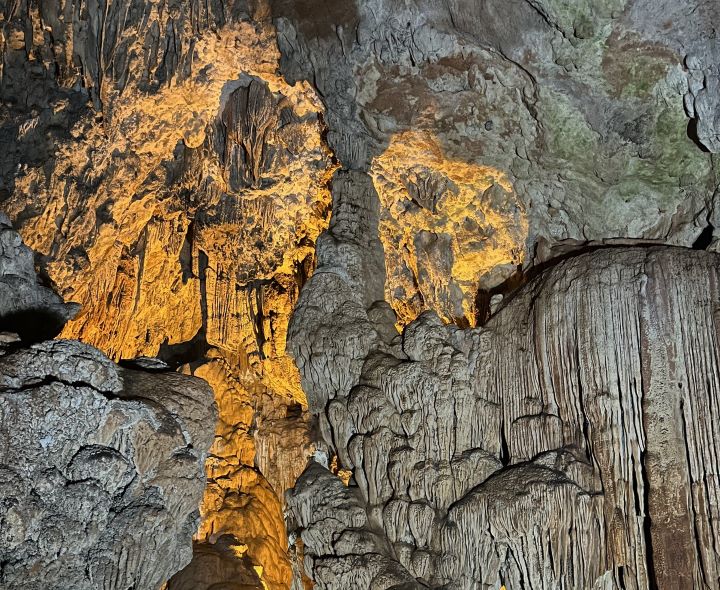 Nguom Ngao Cave is famous for its majestic stalactites and stalagmites, but fewer people know it also hides small Cao Bang waterfall within its underground chambers. These water features add to the mystical atmosphere of the cave, especially during the wet season.Located just 3 kilometers from Ban Gioc, Nguom Ngao is easily accessible and complements a visit to the main falls. You’ll need a flashlight or headlamp to fully enjoy the deeper sections of the cave.
Nguom Ngao Cave is famous for its majestic stalactites and stalagmites, but fewer people know it also hides small Cao Bang waterfall within its underground chambers. These water features add to the mystical atmosphere of the cave, especially during the wet season.Located just 3 kilometers from Ban Gioc, Nguom Ngao is easily accessible and complements a visit to the main falls. You’ll need a flashlight or headlamp to fully enjoy the deeper sections of the cave.Other Local Cao Bang Waterfall
Scattered throughout Cao Bang are many unnamed or less-documented waterfalls. They are small cascades that appear along trails, beside roads, or near ethnic minority villages. These are often used by locals for bathing or fishing, and stumbling upon one feels like discovering a secret.What to Do at Cao Bang Waterfall
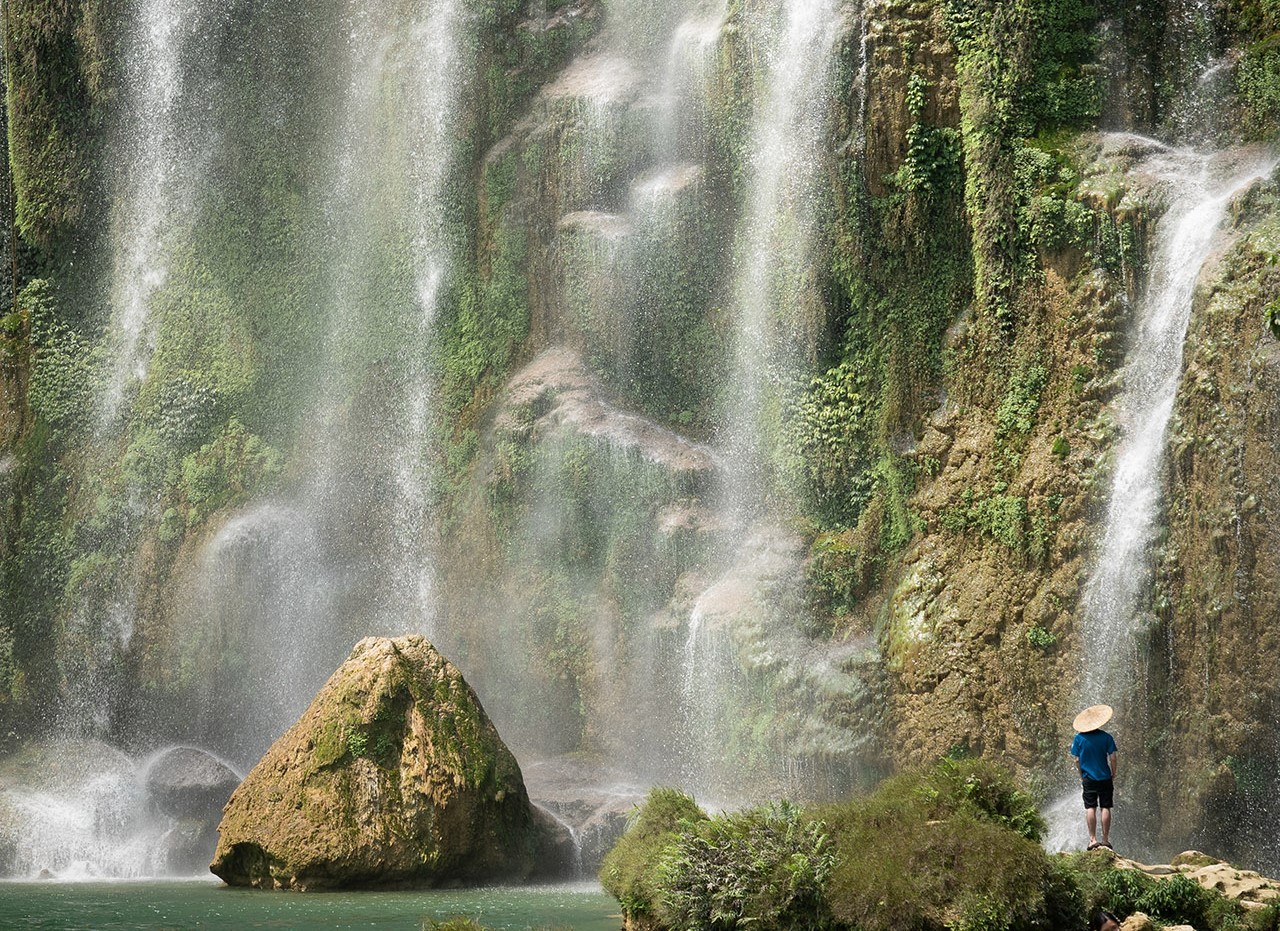 Take your time. Cao Bang is not a place for hurried sightseeing. At Ban Gioc, soak in the view from a different angle or bring a book or journal and enjoy the peaceful environment of a Cao Bang waterfall.At Thang Hen, set up a picnic, go swimming, or simply watch the clouds reflect in the still water. In Nam Tra, the hike itself is the adventure. The deeper you go, the more you hear the forest and the whisper of water ahead. The cave waterfalls in Nguom Ngao add an element of surprise and wonder to an already fascinating site.Photography lovers will find endless subjects here: light playing through trees, traditional wooden homes, the textures of wet rock, and the smiles of local children. And if you have the chance to stay in a homestay, listen to the stories of the people who live near these Cao Bang waterfall – they often know legends that have been passed down for generations.
Take your time. Cao Bang is not a place for hurried sightseeing. At Ban Gioc, soak in the view from a different angle or bring a book or journal and enjoy the peaceful environment of a Cao Bang waterfall.At Thang Hen, set up a picnic, go swimming, or simply watch the clouds reflect in the still water. In Nam Tra, the hike itself is the adventure. The deeper you go, the more you hear the forest and the whisper of water ahead. The cave waterfalls in Nguom Ngao add an element of surprise and wonder to an already fascinating site.Photography lovers will find endless subjects here: light playing through trees, traditional wooden homes, the textures of wet rock, and the smiles of local children. And if you have the chance to stay in a homestay, listen to the stories of the people who live near these Cao Bang waterfall – they often know legends that have been passed down for generations.What to eat on your first visit to Cao Bang Waterfall, Vietnam?
Cao Bang food is a wonderful surprise. The province is known for dishes that reflect its cool climate and ethnic diversity.
Start with “pho chua” (sour noodle soup), a specialty of Cao Bang that mixes rice noodles, pork belly, pickled vegetables, peanuts, and a tangy dressing. Banh ap chao, a kind of deep-fried pancake filled with duck eggs and pork, is crispy and satisfying. Try roasted duck with seven spices, a local delicacy in Trung Khanh.Also common are dishes made from forest vegetables and herbs. If you’re hiking, try “com lam”, sticky rice cooked inside bamboo tubes. It’s portable, delicious, and uniquely fragrant.At many homestays and local restaurants, you’ll be treated to meals cooked over firewood, featuring locally sourced ingredients, such as corn wine, wild mushrooms, mountain greens, and river fish.Conclusion
Cao Bang waterfall is more than a natural landmark – they are woven into the life, legends, and landscape of the province. From the iconic majesty of Ban Gioc to the quiet charm of Thang Hen, the hidden flow of Nam Tra, and the cave falls of Nguom Ngao, each offers a different kind of encounter with nature.
Far from the bustling cities and mainstream tourist routes, these Cao Bang waterfall offer a path into a slower, deeper Vietnam. A place where water carves stone, time flows gently, and every trail invites you to listen, feel, and truly arrive.If you’re planning a trip to Northern Vietnam, don’t just stop at the popular sights. Let the Cao Bang waterfall guide your journey – and you may find more than just beautiful views. You might find peace, connection, and stories that linger long after the mist has settled.